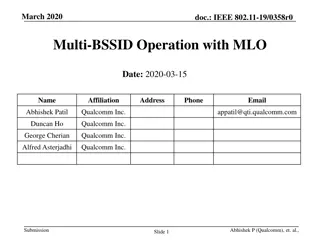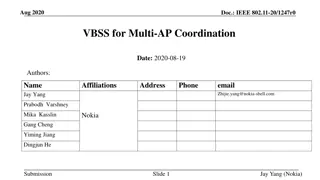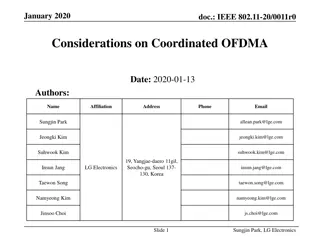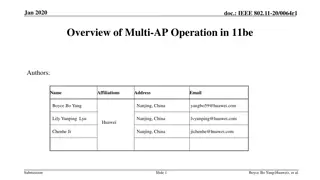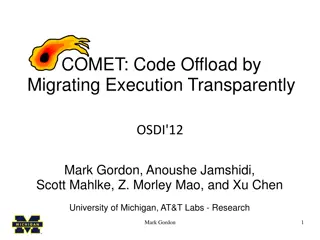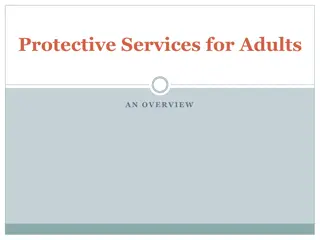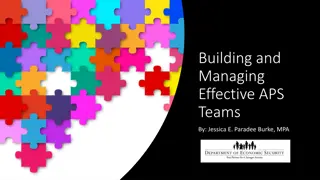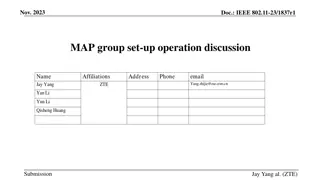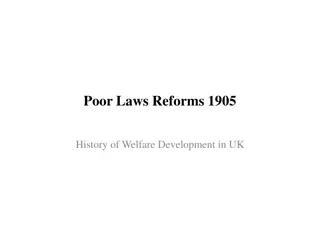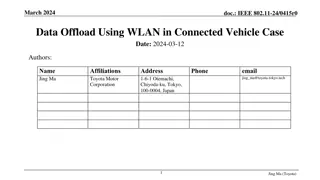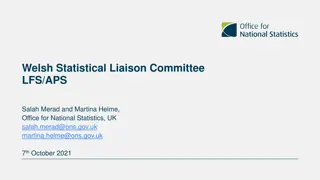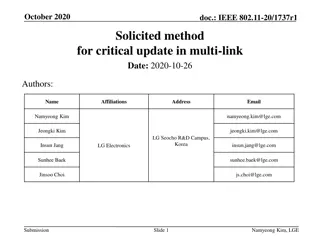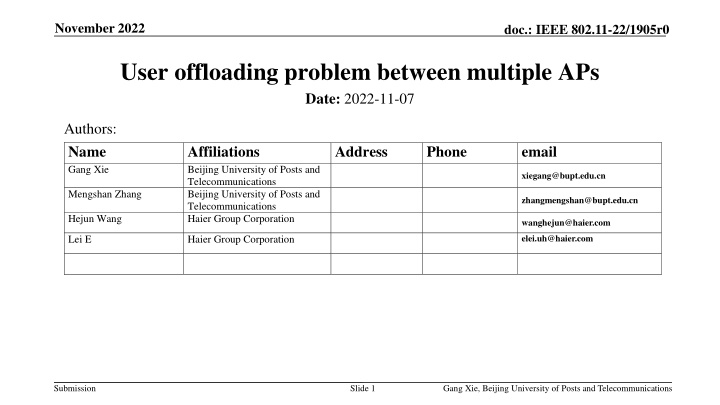
Optimizing User Offloading Between Multiple APs in IEEE 802.11 Networks
Explore a solution for user offloading issues in IEEE 802.11 networks, utilizing multi-AP coordination to balance load, reduce collisions, enhance communication quality, and improve spectrum efficiency. The proposal involves cooperative communication modes among APs to transfer overloaded users to less burdened APs, ultimately enhancing system performance.
Download Presentation

Please find below an Image/Link to download the presentation.
The content on the website is provided AS IS for your information and personal use only. It may not be sold, licensed, or shared on other websites without obtaining consent from the author. If you encounter any issues during the download, it is possible that the publisher has removed the file from their server.
You are allowed to download the files provided on this website for personal or commercial use, subject to the condition that they are used lawfully. All files are the property of their respective owners.
The content on the website is provided AS IS for your information and personal use only. It may not be sold, licensed, or shared on other websites without obtaining consent from the author.
E N D
Presentation Transcript
November 2022 doc.: IEEE 802.11-22/1905r0 User offloading problem between multiple APs Date: 2022-11-07 Authors: Name Gang Xie Affiliations Beijing University of Posts and Telecommunications Beijing University of Posts and Telecommunications Haier Group Corporation Address Phone email xiegang@bupt.edu.cn Mengshan Zhang zhangmengshan@bupt.edu.cn Hejun Wang wanghejun@haier.com elei.uh@haier.com Lei E Haier Group Corporation Submission Slide 1 Gang Xie, Beijing University of Posts and Telecommunications
November 2022 doc.: IEEE 802.11-22/1905r0 Abstract The Multi-AP coordination has been discussed as one of the main features in 11be. It is proposed that sharing AP and shared AP can share resources through the configuration of AP protocol [1]. It is proposed that AP can avoid interference by controlling power. [2] By using the proposed method of multi-AP coordination setting, AP can communicate with STA associated with neighboring AP [3]. Submission Slide 2 Gang Xie, Beijing University of Posts and Telecommunications
November 2022 doc.: IEEE 802.11-22/1905r0 Introduction Due to the uneven distribution of APs, some APs are overloaded, the collision probability increases, the communication quality of some STAs decreases, the spectrum efficiency decreases, and STAs seize the channel resources. We propose a multi-AP cooperative communication mode, which can balance the load among APs, reduce the transmission collision probability, increase the transmission rate of STA, reduce the time delay, improve the communication reliability and improve the spectrum efficiency of the system. Unload some STAs in the overloaded AP network to the AP network with lower load through the coordinated scheduling mode of the main AP or the coordinated communication mode of the AP. Submission Slide 3 Gang Xie, Beijing University of Posts and Telecommunications
November 2022 doc.: IEEE 802.11-22/1905r0 System Model System Model There are multiple AP networks in the system, and AP networks can communicate with each other [3] 1. SAT1~STA2 are in the BSS3 service set of AP3. 2. SAT6~STA7 are in the BSS2 service set of AP2. 3. SAT2~STA5 are in the BSS1 service set of AP1. Submission Slide 4 Gang Xie, Beijing University of Posts and Telecommunications
November 2022 doc.: IEEE 802.11-22/1905r0 Step 1: Setup Neighbor AP Neighboring APs can discover each other by sending beacon frames. Neighboring APs discover each other and establish AP groups Submission Slide 5 Gang Xie, Beijing University of Posts and Telecommunications
November 2022 doc.: IEEE 802.11-22/1905r0 Step 2: AP1 sends a broadcast for help When the AP feels overloaded (the number of access users exceeds a threshold), it issues a request for help and reaches each AP in the group by broadcasting it within the group. AP1 sends a request to other AP in the group. source AP-id source BSS-id Suggest STA-List AP3 response information to AP1 after simple calculation. source AP-id source BSS-id Suggest STA-List Submission Slide 6 Gang Xie, Beijing University of Posts and Telecommunications
November 2022 doc.: IEEE 802.11-22/1905r0 Step 3: AP1 uninstalls users to AP3 During channel monitoring, AP1 tells the STA2 to uninstall to target AP3 through trigger, and sends the authentication in AP3 to the user. Submission Slide 7 Gang Xie, Beijing University of Posts and Telecommunications
November 2022 doc.: IEEE 802.11-22/1905r0 Step 4: Unload user access AP3 AP1 STA2 AP3 Association establishment Uninstall successfully Data transmission 1. AP1 has transmitted AP3 information to STA through the trigger, and STA can directly access AP3. 2. STA2 has established a connection with AP3 and feeds back to the AP, disconnecting AP1 from STA2 3. STA2 is successfully connected to AP3 and can transmit data Submission Slide 8 Gang Xie, Beijing University of Posts and Telecommunications
November 2022 doc.: IEEE 802.11-22/1905r0 Summary - I STA2 accesses AP3 and AP1 successfully unloads the user to AP3. Submission Slide 9 Gang Xie, Beijing University of Posts and Telecommunications
November 2022 doc.: IEEE 802.11-22/1905r0 Summary - II Summary: This paper describes in detail an STA transfer method based on multi-AP cooperation, which is applicable to multi-AP collaborative communication. Contribution: Through the cooperation mode among multiple APs, the user unloading between APs is completed, the load balance between APs is achieved, the resources between Wi-Fi are fully utilized, and the communication quality of users is improved. Submission Slide 10 Gang Xie, Beijing University of Posts and Telecommunications
November 2022 doc.: IEEE 802.11-22/1905r0 References [1] 11-20-0560-00-00be-multi-ap-configuration-and-resource-allocation [2] Coordinated Spatial Reuse Operation [3] 11-19-1895-03-00be-setup-for-multi-ap-coordination Submission Slide 11 Gang Xie, Beijing University of Posts and Telecommunications


